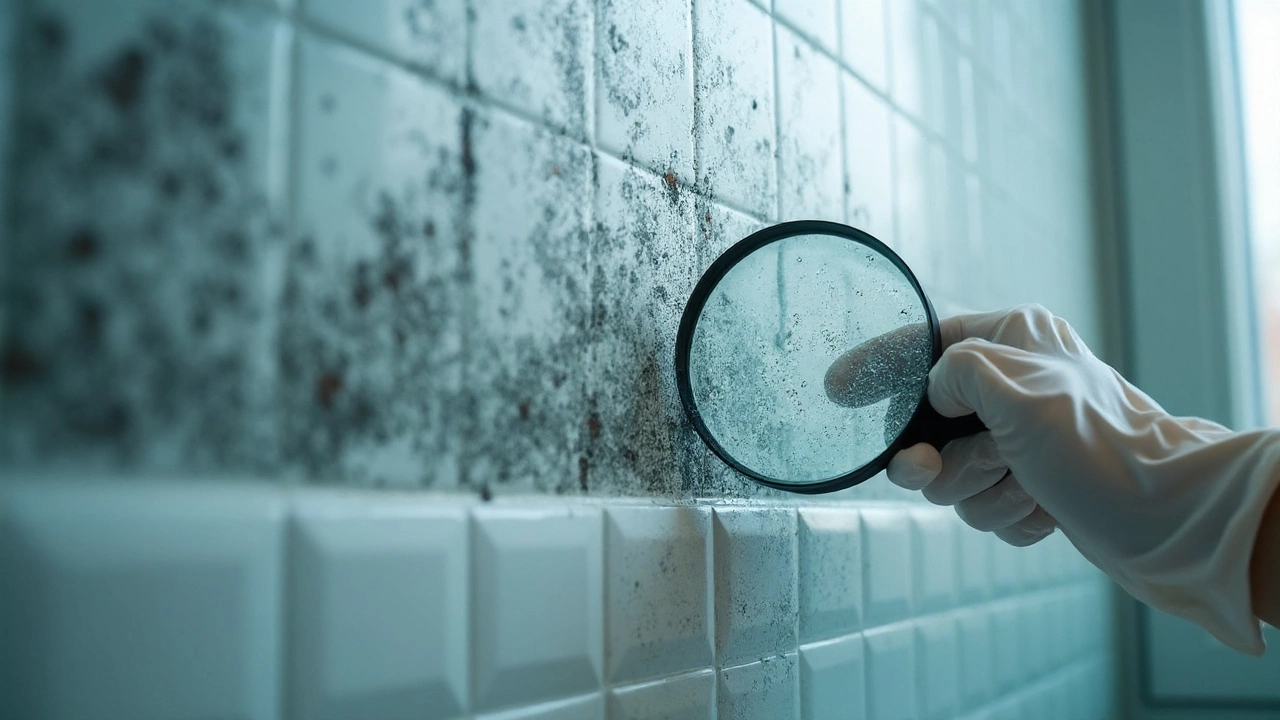Think you can ignore a fuzzy green patch on your wall? Think again—mold in buildings can do far more than just mess up how a room looks. Strangely, you might walk into an office or flat, get that weird musty whiff, and brush it off as "just old building smell." But hidden mold pockets can be living rent-free behind walls, under floors, or even inside your air vents, making your immune system do overtime and sometimes stirring up symptoms that feel like the flu but just won't go away. Stories keep popping up: families having odd rashes, sneezing fits that come and go, or that classic tired-all-the-time feeling—especially in notoriously damp British weather. It's not just hypochondria, either; real science proves indoor mold can trigger illness, and some types are far nastier than you might think. So, should you actually be worried about mold making you sick? The short answer: yes, and here's why you shouldn't just slap a coat of paint over the problem.
Why Mold Thrives Indoors—and Why It’s Hard to Kill
If you’ve ever had damp patches under the window sills or peeled back vinyl flooring to find black stains, you already know mold loves a good British building. Modern insulation holds in heat but traps moisture too, so whenever windows stay shut, you hang laundry indoors, or there's a tiny leak, that’s prime mold territory. Mold reproduces using spores that are basically little floaty seeds drifting everywhere—according to Public Health England, just opening a window or sneezing can get them airborne. You can’t really escape spores, as they’re even outside floating on the breeze, but they need the right conditions inside: moisture, warmth, organic material to snack on, and a bit of darkness. The National House Building Council found that basements and north-facing rooms get the worst of it, but bathrooms, attics, and anywhere with a hidden leak can quickly become a mold party zone.
Stopping mold once it gets going isn’t as easy as just scrubbing the walls. There are entire building blocks in London where landlords have tried just that, only for stains to come back months later. Mold can burrow into drywall, under floorboards, and into the very insulation you thought kept your home comfy. This goes the same for office buildings—aging air ducts can hold years of dust and condensation, so spores have endless places to hide. Mold’s stubborn because the tiniest patch you miss can regrow, and some species (like famous black mold—Stachybotrys chartarum) only need about a 48-hour window of damp conditions to come back stronger. Trying to dry out deeply-infested walls is a nightmare, too; the fibers in building materials give spores crevices to latch onto, especially after water damage from burst pipes or storm leaks. Just covering up mold stains with paint doesn’t kill it either—it’s still alive, just momentarily out of sight.
If you want to know why the UK struggles with building mold, it boils down to our climate, old housing stock, and a dash of bad habits. Older Victorian or Edwardian houses love to trap moisture, especially with original plaster, old brick (which can "breathe" moisture in and out), and lack of modern ventilation. Even new flats aren’t off the hook if their construction corners got cut, or their windows keep in more moisture than intended. Winter months are absolute nightmares: heating creates temperature differences that cause condensation on cold walls and windows—for example, you often wake up to droplets collecting on the glass. Mold takes full advantage of this, kicking off growth spurts overnight. Handy tip: if your bathroom mirror steams up and the window doesn’t open, you’re basically handing mold an invitation. So, if you spot signs—soggy patches, paint bubbling, musty smells—it’s time to act.
How Mold Affects Your Health—And When to Really Worry
Think all mold just means a hayfever-like sneeze here and there? It goes deeper—mold can genuinely make some people sick, and that’s not just a scare story. NHS guidelines list coughing, throat or eye irritation, and asthma flare-ups among the top complaints for mold-exposed people. Those with weaker immune systems—like infants, seniors, or anyone with respiratory issues such as asthma—face bigger risks. For example, one girl in Manchester developed constant nosebleeds, which the family later linked to hidden black mold in her bedroom wall. The local council got involved, and, after proper mold remediation, the symptoms vanished. True story—mold can be that sneaky.
The health symptoms linked to mold aren't always dramatic or immediate, which is why so many folks shrug them off. Here’s a list of real, specific effects people get from indoor mold exposure:
- Persistent coughing or wheezing that doesn't quit with the seasons
- Blocked, runny nose and sore throat, especially in the morning
- Red, itchy, or watery eyes that clear up outdoors
- Unusual skin rashes or patchy dryness
- Headaches or weird brain fog (hard to concentrate, especially if you work from home)
- Fatigue that doesn't make sense (you sleep, but still wake up tired)
- Exaggerated asthma symptoms or new asthma diagnosed in adults
- For kids: repeated chest infections, ear infections, or even slower growth (studied in some damp UK council flats)
The nastiest types of mold, like Stachybotrys, create mycotoxins—chemicals that can cause bigger issues if you’re exposed for a long time. There’s a famous study from Finland where people living in water-damaged, moldy buildings had 1.5 times higher rates of respiratory infections compared to neighbors in mold-free blocks. Hospital admission stats back it up: after big London floods, asthma attacks spike for months as people deal with hidden mold festering beneath carpets and behind walls. Even if molds aren’t openly toxic, their spores still act as allergens—meaning they provoke immune reactions that spiral into bigger health messes if you’re constantly exposed.
People often wonder if mold can actually "infect" someone, like catching a cold. You don’t technically "catch" mold itself, but you breathe in spores and bits of mold, and some can get stuck in your airways or sinuses, especially if you’re already run down. Really rare, but not impossible: there are medical cases where people with seriously weak immune systems (think: people on chemo or with HIV) developed mold infections in the lungs, called aspergillosis. But it’s more about your body being constantly barraged by allergens, toxins, and inflammation until you feel "off." The key sign: if you feel worse at home or work, but fine outside, trust your gut and start hunting for hidden mold at the source.

Signs Mold Is Lurking—And How to Find It
You’d think spotting mold would be easy. Not always—sometimes it’s right there as dark stains spreading along the skirting boards, or those dreaded black spots around windows. But other times, it hides. If you have a stuffy smell that never goes away, especially in basements, closets, or rooms with carpet over concrete, you might already have unseen mold. Painting over stains or blasting with bleach can actually just mask the smell, not solve the issue.
Classic signs you’re dealing with a secret mold infestation include:
- Peeling or bubbled paint or wallpaper—especially in corners or ceilings
- Soggy or warped floorboards, indicating moisture trapped below
- Condensation collecting every morning on cold windows
- Clothes or soft furnishings with a persistent musty odour, even after washing
- Unexplained new spots of dirt or "dust" around vents
- Family or colleagues reporting similar symptoms (think cluster: multiple people in a household or office suddenly get sick)
Even landlords now take complaints more seriously—after all, a high-profile UK court case in 2022 saw a landlord fined after tenants developed serious lung problems from repeated mold outbreaks. If a four-year-old can spot the musty smell, so can you. You can also use home mold testing kits—the kind you set out for a few days, which then develop spots if spores are present. But be warned, most only tell you that mold exists, not where it’s hiding.
A professional look, like from certified mold inspectors, involves thermal imaging (to spot damp patches behind surfaces), humidity meters (to locate persistent wetness), and sometimes even wall sampling if things get really serious. If you just want a budget-friendly check, use your hand: run it over walls that feel unusually cold or sticky, especially in corners. It’s far more common in ground floors and basements in London, but don’t rule out leaky attics either. Pay extra attention after water leaks, roof damage, or floods—these "disasters" often kick off a slow-building mold problem that goes unnoticed for months, causing a slow creep in sickness across entire buildings.
| Common Mold Signs | What It Tells You |
|---|---|
| Bubbling paint, wall stains | Moisture trapped inside, likely with active mold behind |
| Musty or earthy odours | Mold spores are present and active, lots of hidden growth |
| Condensation on windows | High humidity, perfect for mold: check seals and sills |
| Unusual fatigue or symptoms in building | Possible mold impact—especially if better outdoors |
If you see or smell any of these things, it’s time to make a plan. Don’t keep waiting for symptoms to magically clear up or the weather to dry out your room—mold spores won’t leave on their own.
Tips for Beating Mold Before It Makes You Sick
Catching mold early is your best shot at staying healthy, and the battle isn’t just for those renovating ancient London flats. Here’s what works in real homes:
- Mold sickness thrives on moisture, so cut out damp first: always use extractor fans in showers and kitchens. Keep lids on pots when boiling, air out the bath after use, and don’t dry washing indoors unless you must.
- Open windows daily—even 15 minutes helps. It seems simple, but most forget: fresh air screws up the cozy routine mold loves.
- If you spot stains or peeling, act fast. You need to remove it, not just cover. Scrub small spots with a proper mold cleaner, not just bleach (bleach only takes care of the visible layer, not the roots).
- Use a dehumidifier. If your indoors hits above 60% humidity, you’re asking for trouble—anything under 50% is safer. Some models now connect to apps so you know your home’s moisture status at a glance.
- Fix leaks immediately: drips under sinks, roof dribbles, or rising damp needs attention—don’t leave them for "later" or hope it’ll dry on its own.
- Replace old carpets or underlay in basements or after water spills, as these often never dry out thoroughly and mold loves them.
- Insulate cold surfaces. Ever seen a wall that’s colder than the others, especially on the north side? Add extra lining or insulation, or move big furniture away so air can circulate.
- Trim back plants near exterior walls—thick foliage locks in moisture and can lead to damp patches inside.
- If symptoms are bad, or the patch is huge, hire a professional. NHS and major UK councils suggest only tackling small patches yourself and calling in trained pros for anything above a half meter squared, especially if it keeps coming back.
And a long-term bonus tip: build in good airflow. When you get the chance—a renovation, new windows, or even choosing not to stuff too much furniture into a room—plan for air to move. Stagnant air traps moisture, while movement dries out the invisible condensation mold loves.
Indoor air quality is nearly invisible as a health risk, but the stats are wild: a study from King’s College London found that children exposed to visible mold are 40% more likely to develop asthma by age 16. Your house or office isn’t just bricks and mortar—it’s where your lungs spend most of their time. Don’t let uninvited guests like mold set the rules. Spot it, understand it, fix it fast. If your nose, skin, or lungs are sending you signals, pay attention—the hidden side of your building might be having a bigger impact than you thought.
